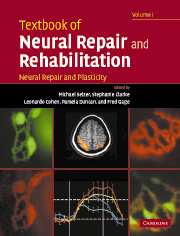Book contents
- Frontmatter
- Contents
- Contents (contents of Volume II)
- Preface
- Contributors (contributors of Volume I)
- Contributors (contributors of Volume II)
- Neural repair and rehabilitation: an introduction
- Section A Neural plasticity
- Section A1 Cellular and molecular mechanisms of neural plasticity
- Section A2 Functional plasticity in CNS system
- 6 Plasticity of mature and developing somatosensory systems
- 7 Activity-dependent plasticity in the intact spinal cord
- 8 Plasticity of cerebral motor functions: implications for repair and rehabilitation
- 9 Plasticity in visual connections: retinal ganglion cell axonal development and regeneration
- 10 Plasticity in auditory functions
- 11 Cross-modal plasticity in sensory systems
- 12 Attentional modulation of cortical plasticity
- Section A3 Plasticity after injury to the CNS
- Section B1 Neural repair
- Section B2 Determinants of regeneration in the injured nervous system
- Section B3 Promotion of regeneration in the injured nervous system
- Section B4 Translational research: application to human neural injury
- Index
11 - Cross-modal plasticity in sensory systems
from Section A2 - Functional plasticity in CNS system
Published online by Cambridge University Press: 05 March 2012
- Frontmatter
- Contents
- Contents (contents of Volume II)
- Preface
- Contributors (contributors of Volume I)
- Contributors (contributors of Volume II)
- Neural repair and rehabilitation: an introduction
- Section A Neural plasticity
- Section A1 Cellular and molecular mechanisms of neural plasticity
- Section A2 Functional plasticity in CNS system
- 6 Plasticity of mature and developing somatosensory systems
- 7 Activity-dependent plasticity in the intact spinal cord
- 8 Plasticity of cerebral motor functions: implications for repair and rehabilitation
- 9 Plasticity in visual connections: retinal ganglion cell axonal development and regeneration
- 10 Plasticity in auditory functions
- 11 Cross-modal plasticity in sensory systems
- 12 Attentional modulation of cortical plasticity
- Section A3 Plasticity after injury to the CNS
- Section B1 Neural repair
- Section B2 Determinants of regeneration in the injured nervous system
- Section B3 Promotion of regeneration in the injured nervous system
- Section B4 Translational research: application to human neural injury
- Index
Summary
This chapter reviews studies of cross-modal interactions from two perspectives. One is the issue of crossmodal plasticity resulting from sensory deprivation, which is considered in terms of the twin questions: does deprivation of inputs in one sensory modality (1) improve perception in the remaining modalities? and (2) alter neural processing of the remaining inputs? With respect to this issue, plasticity of sensory-perceptual processing is distinguished from that of linguistic processing. Further, the effects of shortterm versus long-term sensory deprivation, and of the age of onset of deprivation are addressed, to the extent that they have been studied. A complementary perspective is offered by investigations of cross-modal involvement and multisensory processing in cortical regions that have traditionally been associated with a single sensory modality. The focus in this chapter is on studies of cross-modal interactions that affect the visual system. Similar interactions affecting the auditory system are reviewed in the previous chapter (this volume) by Rauschecker. The interested reader is referred to a review of the phenomena, neural correlates and possible mechanisms of cross-modal plasticity (Bavelier and Neville, 2002).
Superior non-visual perception in the blind
According to common belief, blindness is associated with superior non-visual perception. However, the empirical literature offers mixed support for this idea, despite over a century of investigation (Griesbach, 1899; Hollins, 1989).
Keywords
- Type
- Chapter
- Information
- Textbook of Neural Repair and Rehabilitation , pp. 180 - 193Publisher: Cambridge University PressPrint publication year: 2006
- 4
- Cited by

